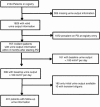Risk factors for loss of residual renal function in children treated with chronic peritoneal dialysis
- PMID: 25874598
- PMCID: PMC4558567
- DOI: 10.1038/ki.2015.108
Risk factors for loss of residual renal function in children treated with chronic peritoneal dialysis
Abstract
In dialyzed patients, preservation of residual renal function is associated with better survival, lower morbidity, and greater quality of life. To analyze the evolution of residual diuresis over time, we prospectively monitored urine output in 401 pediatric patients in the global IPPN registry who commenced peritoneal dialysis (PD) with significant residual renal function. Associations of patient characteristics and time-variant covariates with daily urine output and the risk of developing oligoanuria (under 100 ml/m(2)/day) were analyzed by mixed linear modeling and Cox regression analysis including time-varying covariates. With an average loss of daily urine volume of 130 ml/m(2) per year, median time to oligoanuria was 48 months. Residual diuresis significantly subsided more rapidly in children with glomerulopathies, lower diuresis at start of PD, high ultrafiltration volume, and icodextrin use. Administration of diuretics significantly reduced oligoanuria risk, whereas the prescription of renin-angiotensin system antagonists significantly increased the risk oligoanuria. Urine output on PD was significantly associated in a negative manner with glomerulopathies (-584 ml/m(2)) and marginally with the use of icodextrin (-179 ml/m(2)) but positively associated with the use of biocompatible PD fluid (+111 ml/m(2)). Children in both Asia and North America had consistently lower urine output compared with those in Europe perhaps due to regional variances in therapy. Thus, in children undergoing PD, residual renal function depends strongly on the cause of underlying kidney disease and may be modifiable by diuretic therapy, peritoneal ultrafiltration, and choice of PD fluid.
Figures




References
-
- Wang AY, Lai KN. The importance of residual renal function in dialysis patients. Kidney Int. 2006;69:1726–1732. - PubMed
-
- Marron B, Remon C, Perez-Fontan M, et al. Benefits of preserving residual renal function in peritoneal dialysis. Kidney Int. 2008;73:S42–S51. - PubMed
-
- Perl J, Bargman JM. The importance of residual kidney function for patients on dialysis: a critical review. Am J Kidney Dis. 2009;53:1068–1081. - PubMed
-
- Moist LM, Port FK, Orzol SM, et al. Predictors of loss of residual renal function among new dialysis patients. J Am Soc Nephrol. 2000;11:556–564. - PubMed
-
- Hidaka H, Nakao T. Preservation of residual renal function and factors affecting its decline in patients on peritoneal dialysis. Nephrology. 2003;8:184–191. - PubMed
Publication types
MeSH terms
Substances
LinkOut - more resources
Full Text Sources
Other Literature Sources
Medical

